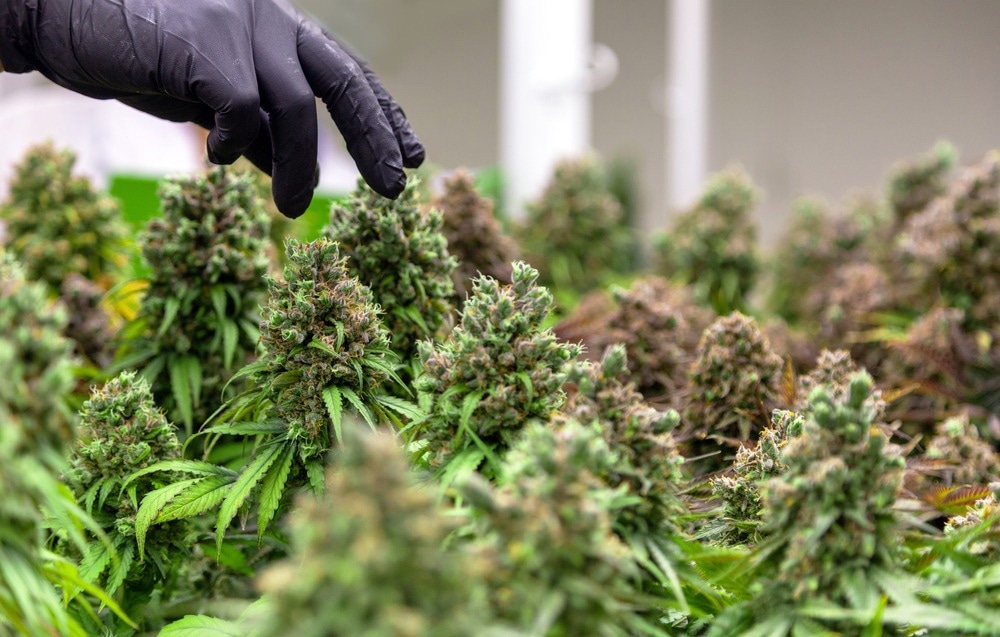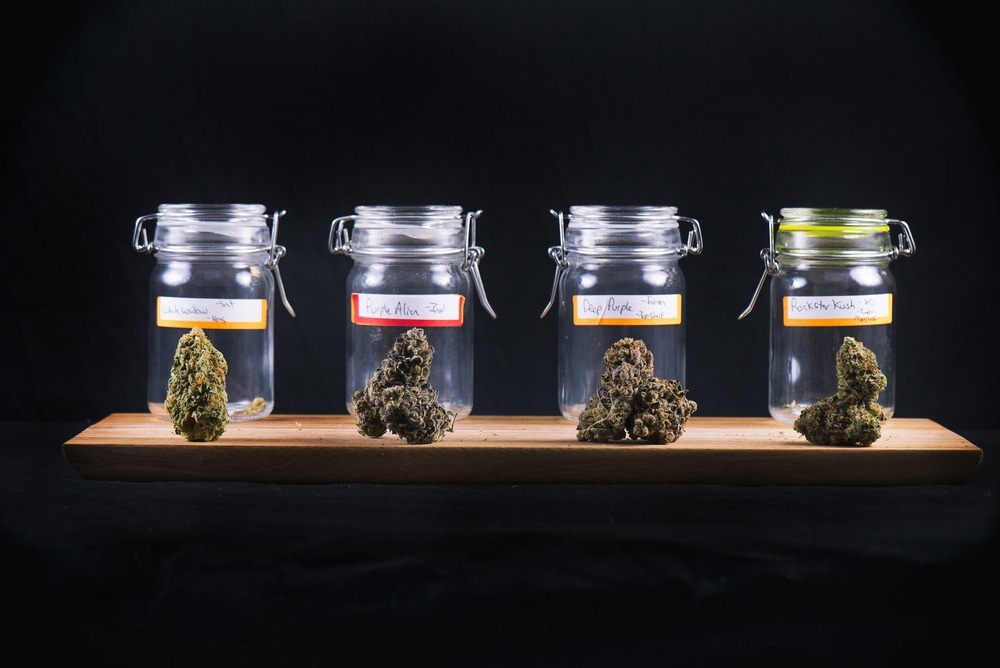The term cannabinomics refers to the broad, large-scale analysis (imparting the –omics suffix) of the chemical content of cannabis, usually achieved by combining various types of separation chromatography and analytical techniques such as mass spectrometry or nuclear magnetic resonance spectroscopy.

Image Credit: MR.Yanukit/Shutterstock.com
Cannabis is a highly variable group of plants containing numerous closely related species and subspecies, with extensive diversity originating from decades of hybridization by humans. Cannabis indica and Cannabis Sativa are the two species most commonly utilized for medicinal or recreational purposes, and through generations of selective breeding, contain a relatively higher Δ9 -tetrahydrocannabinol (THC) and cannabidiol (CBD) content than wild-type counterparts.
Typically, indica strains reportedly contain a roughly more balanced concentration of these two major cannabinoids, while satvia strains contain relatively more THC than CBD, proving a more "body" or "head" based high, respectively. However, extensive hybridization has resulted in significant genetic and chemotaxonomic overlap between the two species. The colloquial terms used to describe the consumer's experience may not accurately reflect the genetic heritage or phenotype of the plant.
In addition to psychoactive cannabinoids, a variety of other potentially metabolically active compounds may be present in differing concentrations within cannabis, influencing flavor and the effect on the consumer. Cannabinomics is useful in classifying cannabis strains and investigating the effect of differing compound concentrations on the end user. Further, the correlation between agricultural practices and the end product can be better interpreted by thorough chemical analysis, allowing optimization of growth conditions such as light and fertilizer use.
The identification of metabolically active compounds and their biological function could also be of use in drug discovery and for the synthetic production of cannabinoid compounds. Within this article, the classification of cannabis using cannabinomics will be explored, and the potential downstream applications will be discussed.
How many chemicals does cannabis contain?
Aliferis and Bernard-Perron state that as of 2020, around 600 metabolites of cannabis had been isolated, around one-fifth of which were cannabinoids. THC and CBD are the two major cannabinoids common to all cannabis strains, the former representing the main psychoactive component, while CBD has attracted attention owing to reported anti-oxidant, anti-inflammatory, and analgesic properties.
Terpenes are another major class of compounds commonly generated in various cannabis strains and are mainly associated with flavor and fragrance. The presence of cannabinoids and terpenes evolved in cannabis for various purposes, such as protection from pests and pathogens or for the attraction of pollinators, and both share similar biosynthetic pathways and are generated from the same geranyl diphosphate precursor.
Terpenoid profiles can be used to classify cannabis chemovars (chemical varieties) and potentially predict the physiological effects when consumed. The analysis of metabolically active compounds originating from cannabis is also of interest when present in the blood, urine, body tissues, medicines, and food products for research, regulatory, and law enforcement purposes, and thus adaptation of separation methods are usually required to optimally extract the variety of hydro- and lipophilic compounds potentially present in these diverse mediums. Both solid and fluid-based extraction methods are broadly employed during cannabinoid and terpenoid separation, with the specific set-up determined by the range of compounds optimized for extraction. Once separated, the various chemicals can be identified by analytical methods such as mass spectrometry or nuclear magnetic resonance spectroscopy.
How are cannabis strains classified?
Within the medicinal and recreational marijuana user community, the terms indica and satvia indicate the type of high imparted, the former being more "body", and the latter more "head" focused. These names are historically associated with strains of cannabis originating from particular global regions, and the effect on the user has been associated with differing THC and CBD concentrations. However, as discussed, extensive hybridization has led to extreme mixing of genetic heritage between almost all commercially or illicitly available marijuana, and thus these terms are not particularly useful from a taxonomic perspective.
Fischedick et al. (2017) developed a cannabis classification system based on their terpenoid profile, identifying 13 chemovar classes divided into five major characteristics with differing secondary characteristics. For example, the "blue dream" and "strawberry" classes of marijuana present the terpene myrcene most dominantly, with the former containing α-pinene and β-pinene in a roughly 2 to 1 ratio and the latter containing trans-ocimene in greater quantity than limonene.
While different strains of cannabis contain a wide variety of terpenoids in potentially wildly differing quantities, those within the same class are grouped by their major constituent and the ratio of other compounds present in high concentration. Within each class, a number of cultivars are generally commercially available, which may present differing cannabinoid and terpenoid fingerprints while still fitting within the parameters of the class. For example, within the Fischedick study, "Strawberry Haze" and "Strawberry Cough" cultivars were obtained for analysis from the Strawberry class, while the "OG Kush" class contained ten different cultivars, including "Hardcore OG" and "Louis XIII OG Kush".

Image Credit: Roxana Gonzalez/Shutterstock.com
What are the applications of cannabinomics?
The genes of the cannabis plant instruct for the transcription of proteins and enzymes involved in the biosynthesis of the numerous cannabinoids and terpenoids found within. Understanding this biosynthetic pathway thereby allows these products to be produced via genetic engineering. Several research groups have achieved the biosynthesis of cannabinoid compounds within yeast, which can be separated and collected to obtain the pure substance.
Luo et al. (2019) utilized yeast in this way by firstly modifying the native mevalonate pathway to produce a high quantity of geranyl phosphate precursor and also introduced genes from the cannabis plant that code for enzymes involved in the subsequent conversion of the precursor to olivetolic acid, an essential step in the ultimate generation of cannabinoids. The major cannabinoid generated was dependent on the fatty acid feedstock provided to the yeast during growth, and further optimization will allow more pure products to be generated in greater quantity.
Biosynthesis of complex cannabinoids and terpenoids in this manner could ultimately be of use in the manufacture of cannabis products, providing greater chemical consistency and potentially avoiding legal issues surrounding cannabis cultivation. Importantly, the ability to specifically manufacture these compounds in good quantity allows their physiological function to be investigated in isolation, possibly revealing metabolic activity with some influence on drug experience or with medical drug lead potential.
References
- Aliferis, K. A. & Bernard-Perron, D. (2020). Cannabinomics: Application of Metabolomics in Cannabis (Cannabis sativa L.) Research and Development. Frontiers in plant science, 11, 554. https://doi.org/10.3389/fpls.2020.00554
- Vásquez-Ocmín, P. G., Marti, G., Bonhomme, M., Mathis, F., Fournier, S., Bertani, S., & Maciuk, A. (2021). Cannabinoids vs. whole metabolome: Relevance of cannabinomics in analyzing Cannabis varieties. Analytica Chimica Acta, 1184, 339020. https://doi.org/10.1016/j.aca.2021.339020
- Nagegowda, D. A. (2010). Plant volatile terpenoid metabolism: Biosynthetic genes, transcriptional regulation and subcellular compartmentation. FEBS Letters, 584(14), 2965–2973. https://doi.org/10.1016/j.febslet.2010.05.045
- Luo, X., Reiter, M. A., D’Espaux, L., Wong, J., Denby, C. M., Lechner, A., Zhang, Y., Grzybowski, A. T., Harth, S., Lin, W., Lee, H., Yu, C., Shin, J., Deng, K., Benites, V. T., Wang, G., Baidoo, E. E. K., Chen, Y., Dev, I., Keasling, J. D. (2019). Complete biosynthesis of cannabinoids and their unnatural analogues in yeast. Nature, 567(7746), 123–126. https://doi.org/10.1038/s41586-019-0978-9
- Fischedick, J. T. (2017). Identification of Terpenoid Chemotypes Among High (−)-trans-Δ9- Tetrahydrocannabinol-ProducingCannabis sativaL. Cultivars. Cannabis and Cannabinoid Research, 2(1), 34–47. https://doi.org/10.1089/can.2016.0040
Further Reading